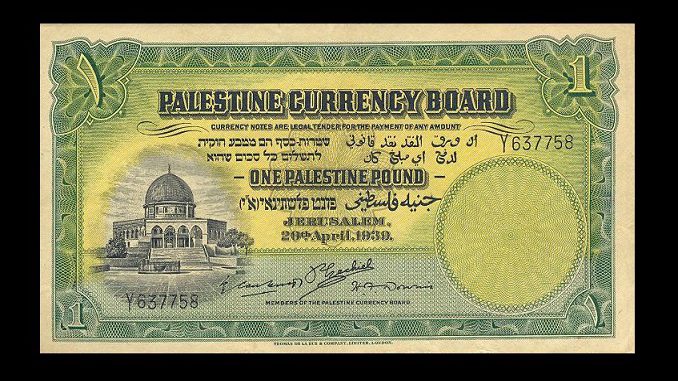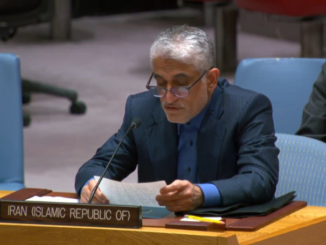
By Ahmad Amr
You can make up history and you can mix up mythology with history, but you can’t make up ancient coins. One of the great things about ancient coins is that they give us a tangible link to the most recognizable images of antiquity.
Coins are also a scientific way to determine the culture and language of the craftsmen that struck them and the community that used them as their daily currency.
Ancient coins age well. When you hold an ancient coin with the image of a Roman Emperor or a Greek Goddess or Cleopatra or the Thurgau of the Ottoman Sultans, you literally have history in the palm of your hands. You touch a piece of hand struck art that has passed through the fingers of a hundred generations. The coins that have circulated in Palestine and the Galilee over the ages give a panoramic view of the profound influence of Greek, Roman, Arab, Crusader and Ottoman culture on the Palestinians and the Galileans.
Danny Danon, Israeli ambassador to the United Nations, recently made the claim that he has a coin that is “clear evidence that proves the ancient connection of Jews to Jerusalem. These are the facts. These are the facts this body wishes to ignore.”
It’s easy to ignore the short history of Jewish coins because there’s very little to ignore. We only ask that the Israeli ambassador and Netanyahu reciprocate by coming up to speed on the coins of the Tyrians and Galileans and Nabateans and the coins of ancient Phoenician and the Greek city-states along the coast of Palestine, Galilee and Lebanon.
This was Palestine currency b4 1947.does trump known s this. pic.twitter.com/opiTyRKU5a
— mohamed (@mohskies) December 9, 2017
There is no denying that Jews did strike their own “Shekel of Israel” during the First Jewish Uprising in 67 AD but it was never a sovereign currency except in the minds of the Zealots who led the uprising.
Until the creation of the State of Israel, that’s pretty much the history of what turned out to be the first and last ancient Israelite coin struck in Jerusalem or Palestine.
Danon should learn of the Tyrian Shekel which was first minted in 126 BC with Greek letters. The Tyrian Shekel came to dominate the economy of Phoenicia and Palestine. The Shekel was a Phoenician currency long before it was the currency of the State of Israel.
The Romans and the Byzantines continued using Greek letters until the Arab conquest in the seventh century. Even the smallest collector can afford to buy an Arab, Byzantine, Crusader or Ottoman coin – the coins of the realm until the British Occupation of Palestine in the early 20th century.
Any coin dealer can tell you when an old Greek or Phoenician or Roman or Ottoman coin was struck and where it was struck. Just because a coin is ancient doesn’t mean it is rare and doesn’t mean it was struck where it was found.
According to Danon’s legal theory – the keys of the Galilee should immediately be returned to the Greek or Lebanese Government or only to native Galileans who can trace their lineage back to a time when Greek and Roman and Byzantine coins were the coin of the realm. The claims of the indigenous inhabitants of the Galilee and the Coast of Palestine are the only legal claims that can stand in a court of law. And the same legal standard applies to the claims of the indigenous Semitic natives of Jerusalem and Gaza, the West Bank and the Negev.
It’s Danon who can’t handle the truth. The truth is that the Jews were late comers to the art of striking coins. The Nabataeans were striking coins a hundred years before the birth of Jesus Christ and the Phoenicians were striking coins two centuries before the Nabateans.
The Shekel of Tyre set the gold standard for coinage and was accepted as legal tender all over the Greek and Roman Empire. The Tyrian Shekel is one coin every Jewish numismatist should know all about. Even in the time of Jesus, the Phoenician Tyrian Shekel was the only coin a Jew could use to pay the Temple Tax. That was the currency used to bribe Judas Iscariot.
In Jewish tradition, the Lord spoke to Moses saying “When you take a census of the sons of Israel to number them, then each one of them shall give a ransom for himself to the Lord. This is what everyone who is numbered shall give: half a shekel according to the shekel of the sanctuary and half a shekel as a contribution to the Lord.”
A little knowledge of numismatics is a dangerous thing. Whoever wrote that account of Moses and the Temple Tax didn’t have a clue about the history of coins and neither does the Israeli ambassador. There were no coins in the time of Moses or Solomon.
The great thing about ancient Jewish coins is that there is only one such coin. It is very hard to come by but if you do happen to stumble on the ‘Jewish coin of the realm,’ you can boast of having the entire catalog of ancient Jewish coins in your pocket.
الجنيه الفلسطيني ١٩٢٧ – British Mandate for Palestine currency 1927 pic.twitter.com/ae8AJYFWQv
— nour (@Nornor2Nour) December 11, 2017
The reason the “Shekel of Israel” is so rare is because very few were struck, and they weren’t struck for very long and they were rather crude even by the standards of the ancients that they were probably melted after the revolt. If the Israeli ambassador wants to use ancient coins to get a sense of time and place, he should consider augmenting his one-coin collection with a few common coins used by the ancient Semites of Palestine and the Galilee.
If we were to partition Palestine based on the number of ancient coins that prove a connection to Jerusalem or Galilee, Israel would end up being the size of Gaza. By that ‘legal’ criteria, the biggest slice of holy real estate would have to be awarded to the Galileans and their Lebanese Tyrian cousins or to the Greeks or the Arabs or the Turks.
The Israeli coin trick works both ways. Let the Ambassador search his purse for a coin proving that the ancient Israelites have any historic connection to the Galilee or Gaza or the Negev. He won’t find one and if he could produce one, it is hardly sufficient proof of any significant Jewish presence in the Galilee.
There are no ancient Jewish ruins or ancient Jewish coins in the Galilee because the only Jews who ever managed to conquer it were the sectarian Jewish terrorists of the Irgun and Hagenah. Even if you go by the blemished accounts of Jewish Canon history memorialized in their Hebrew scripture, there never was a Jewish presence in the Galilee prior to the creation of the State of Israel. In fact, there was no Jewish presence along the entire coast of Palestine. The Kingdom of Solomon did not border the Mediterranean.
The Israeli government has saved no expense digging archaeological evidence of the presence of their mythological ancestors on the coast of Palestine and the Galilee. The fact that Israelis can’t produce a single solitary coin to support their claims to the Galilee has never deterred Zionists zealots. Who needs historical proof when the Jews come to the table with a real estate contract signed by their God ‘proving’ that Galilee was conveyed to the Israelites for eternity?
For a thousand years, the coast of Palestine was as Greek as Cyprus and Alexandria. The coins of the region were inscribed with Greek letters, the Linqua Franca of the Eastern Mediterranean.
By the time Edmund Allenby marched into Jerusalem, Palestinians had been doing business using Ottoman currency for four centuries. In the first years of the British occupation, Palestinians started using British occupation coins which replaced the Turkish coins of the Ottoman Empire.
It was not until 1927 that the British decided to introduce Palestinian coins and Palestinian Bank Notes. Because Palestine was a League of Nations mandate, the British could not issue colonial coinage with the image of King George V. Coins are a symbol of sovereignty and Palestine was never a British colony and Palestinians and Galileans were never subjects of the British Crown.
It’s time for the Palestinians and Galileans to bring their coin collection to the negotiating table and demand the right to design and issue two separate currencies. Let Danon show up with his replica of the Shekel of Israel and let the Palestinians and the Galileans show up with their entire coin catalog of Greek, Roman, Byzantine, Arab, Ottoman, Crusader and British Mandate coins which were minted until 1947. It is a catalog that reflects the unique cultural inheritance of the indigenous Semitic speaking people of Palestine and the Galilee.
Today’s Palestinians and Galileans are Arabic speaking descendants of Canaanites, Philistines, Greeks, Jews, Romans, Arabs, Egyptians, Turks, Persians, Armenians and Anatolians. Palestinian and Galilean coins should reflect the full spectrum of that unique identity.
Coins should be minted to memorialize the Nakba and to honor the millions of Palestinians and Galileans who have tasted the bitter fruit of extra-judicial exile for three generations.
They should be minted to remind the world of the unrelenting resistance of the Palestinians and the Galileans.
The should be minted to commemorate every village razed to make way for a homeland as Jewish as England is English.
They should be minted to commemorate Israeli war criminals to make certain that their murderous crime sprees can never be erased from the pages of history.
They should be minted to commemorate the Apartheid Wall and the checkpoints and Israeli jails, the refugee camps; every deranged monster from Lord Balfour to Lord Jared Kushner to Ben Gurion for their role in tormenting and displacing the indigenous people of Palestine and the Galilee.
Coins have always been used for propaganda. Perhaps a coin shoudl be minted to recognize Trump as the last American president who will ever have a say in resolving the Israeli-Palestinian or the Israeli-Galilean conflict.
Let Danon and Nikki Haley pound sand with his one coin which just happened to be a worthless replica.
The Palestinians need no permission to declare their economic independence by issuing their own “resistance currency.”
Resolving the Israeli/Palestinian Coin Conflict can be done unilaterally. The Israelis must not be permitted to appropriate the Shekel. They must be reminded that it was a Phoenician currency for two hundred years before the Jews struck their first and only ancient coin.
Coint must be struck that match the beauty of the ancient Tyrian Shekel and be called Palestinian Shekels or Galilean Shekels. They must be made out of the same 95% silver alloys used by the Tyrian and sold for whatever the market will bear.
That done, paper currency could be made that converts either Palestinian or Galilean Silver Shekels. Throw in a little bitcoin technology and you have a fully functional monetary system. And if you want a model of how that can be done – take notes when Israel issues sovereign bit coins.
In issuing banknotes, I would advise the Palestinians and Galileans to use Arabic, Aramaic, Armenian, Greek and Latin letters to affirm their identity as a people who have dwelt on the shores of what Herodotus called “our sea” since time immemorial.
I would also start by reissuing banknotes that are similar in design to the paper currency of the Palestine Mandate which featured the Dome of the Rock, Rachel’s tomb and the Tower of Ramla. It is perfectly legal to print colonial currency and mint colonial coins that has been demonetized.
The Oslo accord prohibits the Palestinians from issuing their own currency and that’s a good enough reason to tear it up. It’s a 25-year agreement that the Americans and the Israelis had no intention of honoring. The Israelis fought very hard to make their currency the only coin of the realm circulating in the West Bank and Jerusalem. Tel Aviv didn’t care if the Palestinians have a flag or embassies or if they can issue passports. But they draw a red line line at the issuance of Palestinian currency.
The Israelis have used their currency as a form of economic warfare against the surviving indigenous Arabic speaking people of Galilee, the West Bank, Jerusalem, Gaza and Galilee. Abandoning the occupier’s currency will pour hundreds of millions of dollars a month into the hands of the Palestinians and the Galileans and will give their sympathizers around the globe a tangible way to support them.
It will also deprive the Americans of any economic leverage they have on the Palestinians and gain the attention of coin collectors all over the world. At current silver prices, a five hundred commemorative set of coins memorializing every village destroyed by the Israeli ethnic cleansing goons would cost less than ten thousand dollars to produce and could fetch a $50,000 premium from serious collectors and wealthy supporters around the world.
As a start, produce only 10,000 of these sets every year. That’s a cool half-a-billion profit margin that will free the Palestinians and Galileans from having to depend on American aid and set the stage for a viable sovereign currency that competes with the Israeli Shekel.
That done, issue a standard generic silver Shekel to back up Palestinian and Galilean banknotes. Mint as many as the market will bear and sell them for twice the price of production and set a policy that promises to convert all banknotes on demand to generic Shekels.
It’s the best way to send the world a message that the Americans have no constructive role to play in resolving the Israeli-Palestinian coin conflict.
– Ahmed Amr is an American economist and a coin collector who can’t wait to get his hands on the “Adios Trump” Shekel. He is the author of “How to Steal a Billion Dollars” and “The Sheep and the Guardians” and the former editor of NileMedia.com. He contributed this article to PalestineChronicle.com.








Good interesting and entertaining article – but as everyone should know any country that has gone against US$ hegemony has been attacked and destroyed by the US. Israel is well embedded in that system….
The Americans and Israelis can only stop it by landing the Marines in the West Bank and Gaza and Galilee and Jerusalem and going house to house to check who has Palestinian currency in their pockets. The Palestinians don’t need permission from anybody to start mint commemorative coins with intrinsic value. They can do it tomorrow morning and it gives them a path to economic independence and away to memorialize their history and honor their national heroes and show off their architectural cultural legacy.
why do you keep mentioning Galilean as separate from Palestinian?
aren’t Galileans part of the Palestinian people?
Just one point – it’s glaring and ignored in the whole article. In Hebrew, “Palestine” is written (as that was the descriptive term of the Mandate at the time) with “ayin-Yud” in parentheses, meaning “Eretz Israel”, the land of Israel. There is no denying that many institutions at the time on pre-Israel were set up by Jews – banks, post offices, buses, airplanes, all with “Eretz Israel” written on them. As the author said, telltale signs DO exhibit the truth through context.
Dear Friend, The Jewish Shekels were issued by the thousands during the First Revolt (66-70 CE). But they are not the only ancient Jewish coins. Preceding them were small bronze coins with ancient Hebrew inscriptions, issued by the Hasmoneans (descendants of the Maccabees) beginning around 130 BCE. And following the Jewish shekels were the bronze and silver coins (some showing the Temple in Jerusalem) issued during the Second Revolt (132-5 CE). For further information, please read my Handbook of Biblical Numismatics at http://www.amuseum.org/book, which also includes some Muslim coins issued in the Holy Land.